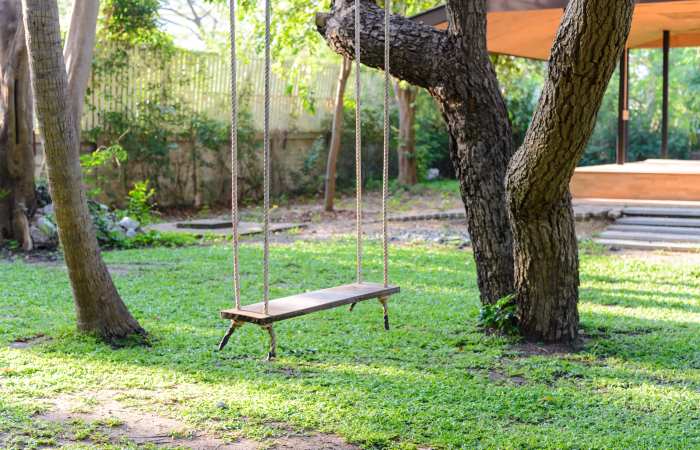Hanging a swing from a tree is simple, right?
Not necessarily. Many homeowners don’t have a tree in their yard with branches growing in the right location for a swing.

In this guide I explain how to hang a swing from a tree with no branches, between two trees, or with angled branches.
I highlight each method’s pros and cons and provide safety tips so that you can choose the best solution to your swing-hanging problem!
How to Hang a Swing
Here are several ways to hang a swing when no acceptable branch is available.
From A Tree Without Branches
When you have a tree without branches, you can create an artificial branch.
This method is best for baby swings, or swings meant for small children since this “branch” cannot support the weight and movement of larger children unless you beef up the engineering.
Step 1.
Locate a healthy tree with a diameter of at least twelve inches. The larger the trunk, the better. Oak is a great choice, but maple, sycamore, and beech are other top picks.
Step 2.
Mark a spot on the trunk between eight to ten feet off the ground. This spot is where your artificial branch will attach.
Step 3.
Drill one hole in the center of your wood plank, about sixteen inches in from the end that is NOT going to support the swing.
Have your helper hold the plank horizontally up to the height marker. Center the pre-drilled hole on the trunk.
Drill through this hole and into the trunk at least four inches, then screw in a bolt until the board is snug, yet moveable.
Step 4.
Level the plank while your helper holds the long end of the plank parallel to the ground.
Drill two secondary holes 3-5 inches to the upper right and upper left of the original hole. The three holes should form an upside-down triangle.
Make sure the trunk is thick behind the new holes. Drill into the tree and install two more bolts.
Tighten all three bolts until the plank is stiff. If the trunk is extra full, you can add more bolts further out for more strength.
Step 5.
The plank should now hang off one side of the tree about 6-12 inches, with the remainder sticking out from the other side.
Step 6.
Attach your swing kit to the long end of this artificial branch. Keep the swing three feet away from the tree trunk for safety.
TIP: For all dual-rope swings, place the upper attachments four inches wider than the width of the swing. This wider stance, with the swing centered between it, helps alleviate any twisting of the swing while in motion.
For example, a 14-inch-wide swing should have the upper attachments 18-inches apart.
For 2×10 plank, I suggest using a strap with hooks around the entire plank once or twice, then hanging the swing from that.
This method helps prevent splitting that could happen over time if you drill holes vertically through the plank to attach your swing.
Pros
- An inexpensive and quick way to place a swing exactly where you want it
- Should cause no harm to the tree
- Blends into the tree for a more natural appearance
- Removable
Cons
- Only recommended for babies and small children
- Requires two people to construct
SAFETY
Inspect the artificial branch often for signs of loose bolts or cracks in the wood. Tighten nuts and assure rope knots are secure.
Inspect any connecting swing hardware for rust or wear and replace as needed.
Do not overload the artificial branch by letting adults or several kids play on the swing at once.
Unless you use heavy-duty planks or even metal, this type of swing support could fail under excessive weight.
Related | How To Hang String Lights In The Backyard
Between Two Trees
You can hang a swing using two nearby trees, especially if those trees have branches far out of reach.
Step 1.
Locate two trees that are between eight to twelve feet apart.
Make sure each trunk is a minimum of eight inches in diameter.
Step 2.
Mark each trunk at the height you wish your crossbeam to sit.
Step 3.
Hold the plank between the two trees and mark four drill holes in a square shape on each side where you know they will bite into the thickest part of the trunk.
Bring the plank back to the ground and drill out these markings.
Step 4.
Lift the plank back up the tree and level it parallel to the ground. Start with one hole on each side and drill through the hole into the trunk at least four inches and screw in a bolt.
Repeat for the remaining six holes.
Step 5.
Attach your swing to the center of this crossbeam using straps, eye-bolts, or other hardware rated to hold a minimum of 1000 pounds.
Pros
- Can support more weight
- Very stable
- Easy to install
Cons
- Need to have trees in close proximity to each other
- The beam can be an eyesore
SAFETY
Choose trees within the recommended spacing. Too close together and the swing could hit the trees during use. Too far apart, and the crossbeam could sag.
The thicker the crossbeam, the more weight it can support. To hang swings for older kids to play hard on, consider laminating two planks together before installing on the trees for even more strength.
Inspect all bolt attachments at the trunk, as well as swing hardware regularly for looseness, rust, or wear. Tighten or replace any issues immediately.
On An Angled Branch
Branches that grow on an angle can still support a swing when you know the right way to hang it.
Step 1.
Locate a healthy branch at least eight inches in diameter.
Step 2.
Measure the width of your swing. Locate two points on the angled branch where you wish to hang the swing, but add four inches to the overall width between these points.
Step 3.
Take a long bit and drill a hole vertically through the branch at each point.
Step 4.
Take a level and place one end under the branch at the lowest hole. Stretch it level, until it’s underneath the higher hole on the angled branch.
Measure the space between the top of the level and the bottom of the second hole.
This offset measurement allows you to “fix” the swing, so both ropes bend at the same point.
If you hang the swing without balancing this distance, the swing will run crooked when you push it, which can be unsafe.
Step 5.
Cut a piece of 1-inch PVC pipe. This pipe needs to be the diameter of the tree branch plus one inch, plus the length of the offset between holes.
For example, a ten-inch diameter branch and a five-inch offset need a pipe cut 16 inches long.
Drill across the top of the pipe 1/2-inch down with a 3/8-inch bit. Find a long nut and bolt that fits across these holes and fastens securely.
Step 6.
Drill out the higher hole in the branch with a 1-inch bit. Place the pipe (with the small holes on top) under this hole and push the pipe through the branch.
Stop once the small holes come through the top of the branch.
Step 7.
Place the long eye-bolt in through the lowest hole and secure with large washers and nut on the top. Tighten.
Feed one rope up through the PVC pipe inside the branch. Tie a large knot in the rope above the pipe. Before taking out the slack in the line, secure the long bolt and nut across the top of the pipe.
The bolt keeps the pipe from slipping out of the tree and also holds the rope knot in place.
Step 8.
Tie the other rope to the eye-bolt, level up the bottoms, and tie on the swing. Now the fulcrum point at the top is even on both sides, and the swing should function perfectly.
Pros
- The swing hangs level and won’t twist
- Works with otherwise hard-to-use branches
- No additional lumber needed
Cons
- Takes a bit more effort to measure/install
TIP – If you hang a swing that uses only one rope, like a tire swing or spider-web swing, you can eliminate the hassle of the offset pipe since you only need one attachment point on the angled branch.
SAFETY
Replace swing rope every two years. Use only marine-grade UV-protected rope or braided polypropylene synthetic rope with high weight ratings.
In Summary
Having a swing in your yard can provide years of fun family activity. That’s why it’s important to learn how to hang a swing from a tree with any kind of branches.
Whether you choose a kid’s swing, or you decide on a porch-style swing for adult relaxation, I hope you find the information in this guide helps with your swing-hanging project!










